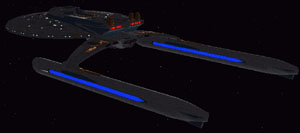
Apollo 1 – aft starboard quarter

Apollo 1 – aft starboard quarter |
The Apollo-class starship is a vessel so unique to the Starfleet that an entirely new classification of ship had to be created for her:
The Mk-XXXII (Mk.32) Prowler.
At turns a perimeter action ship, super scout, ELINT cruiser, destroyer, and frigate, the Apollo class takes on board elements of all these roles to forge her into a very effective smuggler hunter, pirate chaser, and border guard.
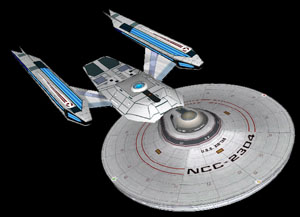
Xir`tan 3 – Okinawa-class frigate |
During the I.S.C War of Pacification 2 (2295-2298) a disproportionate number of Starfleet's smaller vessels were lost in action, mostly during formation engagements. The by-then venerable Okinawa 3-class light frigates (in their Baseline 7 configuration) and their Akula 4-class light destroyer younger sisters were not suited to formation battles. They were never supposed to be a Ship of the Line but due to the nature of the I.S.C. invasion these classes were all too often swept up in the mixed bag that was all Starfleet could respond with. Though Starfleet Command tried to spare these small ships, frigates and even corvettes were often all that were available for the next convoy escort duty or emergency situation.
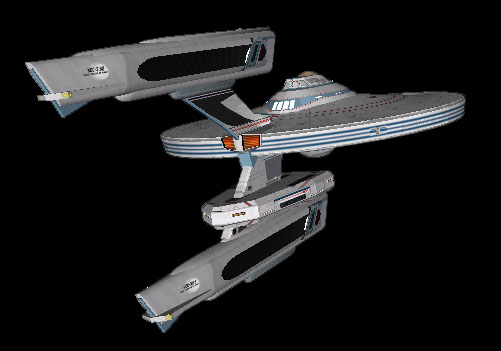
Quiberon Bay 4 – Akula-class light destroyer |
The end result was that Starfleet's patrol force classes were heavily culled.
In the aftermath of the I.S.C. War – and even during the last two years – pirate cartels and organised crime syndicates both Orion and not took extreme advantage of Starfleet's absolute preoccupation by raiding systems, bases, convoys, and whole sectors which had been stripped bare of their protection by the demands of war. Coming out of that war with upwards of a third of the remaining fleet going in for repairs over the next decade and with most of their deep-space scanning arrays destroyed or wrecked, Starfleet was left badly over extended and the Federation they were protecting rendered vulnerable.
What was needed both desperately and immediately was a new kind of perimeter action vessel, and one that could be produced quickly and in large numbers at the locations on the frontier where they could be put to immediate use.
Already noted as a problem in the latter stages of the war as Starfleet drove the I.S.C. out of Federation space and then began pursuing them into theirs, the Federation Homespace Security Agency's (F.H.S.A.) projections for pirate activity only forecast it getting worse. With these warnings ringing loud in the ears of a Starfleet that could not spare ships from the repulsing of an invasion yet was still charged with the defence and protection of Federation citizens from other forms of harm, Starfleet Command re-tasked its smaller interior shipyards with the production of more Okinawa- and Akula-class ships to replace ongoing war losses. Further, they once again turned to the Advanced Starship Design Bureau (A.S.D.B.) and charged them with the development of NXP-2296-PA(X), a new design that had to operate in a post-war environment that included as starting conditions:
Captain Adam Buckner 5 led the A.S.D.B. design team assigned to this pathfinder project for Starfleet. Projecting the best- and worst-case scenarios with regards to sensor overwatch capacity and availability, most likely construction yard sites, probable mission durations, and expected operational regions, his A.S.D.B team would come up with a ship like no other.
One of the early orders of business was a name for the development project. A multitude of ideas were put forth, many linked to wrath, revenge, and defiant or steadfast attributes. Invariably, a Human member of the design team with a classical education and a student of Starfleet history proposed the name Apollo, after the Greek god. When asked to explain why, they noted that amongst that god's custodial charges Apollo had become associated with dominion over colonists and was the patron defender of herds and flocks.
"What better name could there be for a class of ships designed to protect our frontier world colonists, the herds of convoy freighters, and our flocks of innocent travellers from the depredations of raiders, smugglers, pirates, and slavers?"
This was met with thoughtful silence, then resounding approval. The Apollo Class Development Project had been initiated.
The original broad requirements issued by Starfleet led to appraisals of re-working an existing Perimeter Action class to meet the new challenges expected in the post-war environment. Prime among these were the Akyazi 6 and Dupleix 7 classes.
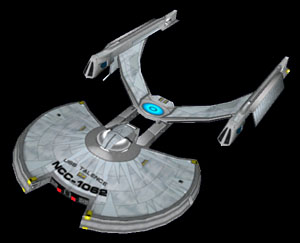
Talence 6 – Akyazi-class perimeter action ship, Arbiter sub-class |
The Akyazi had extreme manoeuvrability and sustainable maximum warp speed going for it. The Dupleix' unique design had extended sprint speed and greater mission endurance on its side. The downsides of each were that the Akyazi was very cramped and had poor on-station time due to lack of crew facilities, requiring the presence of a Large Perimeter Action Ship (PKA) "tender" to extended patrol duration. The Dupleix suffered from relatively poor manoeuvrability when compared to her expected opponents of pirate raiders and renegade Klingon Birds of Prey, and a lack of heavy weaponry for a fast, decisive strike.
In the end it was realised that too much time would be spent trying to shoe-horn in the required additional capabilities to already-specialised vessels; a new design was required. Taking lessons on how to execute specific mission requirements from both these classes and others, and after detailed joint analyses with the F.H.S.A. on precisely what this new class needed to be able to do, a refined set of requirements was drawn up and presented to Starfleet. The new vessel would:
Starfleet received these revised requirements – now touted as the "5-S Criteria" 8 – thoughtfully and soon after approved them. With the green light given, detailed design work began in 2297.
The classic Starfleet saucer was decided upon as the design of choice for the main hull. Thruster locations around the perimeter of the saucer allowed for responsive and precise control of roll, pitch, and yaw and thus improved sublight manoeuvrability. To that end it was further decided that the less massive the hull the better. Further still, to provide the best application of warp dynamics and a form-fitting warp field, it was determined that a saucer diameter fitting inside the optimum spread of the warp nacelles would provide the best return for energy expended, further increasing the ship's engine efficiency.
Many configurations were trialed in simulation studies but a full saucer with no secondary hull was finally decided upon to maximise internal volume and aid with ease of construction over more complicated hull forms. The primary hull of the Okinawa-class was considered before being discarded as too small without a secondary hull to provide additional volume, and the saucer did not lend itself well to simple up-sizing.
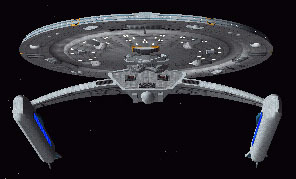
Apollo – fore ventral Note the Klingon design influence |
Taking a leaf from the Klingon design book a more rapier-like hullform was decided upon for a very low forward profile, again to keep the warp field as flat as possible. A good match for the projected necessary interior volume was the Excelsior-class saucer, when downsized to 55% of its original size. The dimensional ratios lent themselves well to simple resizing in this case.
While not a large ship, provision was still made for small craft operations. It was deemed sensible to provide the Apollo class with limited self-repair and maintenance E.V.A capability. To this end, a cramped but still functional shuttle bay was installed in the saucer almost directly under the bridge module, with the shuttle bay doors installed in a fairing on the dorsal surface of the saucer directly in front of the bridge.
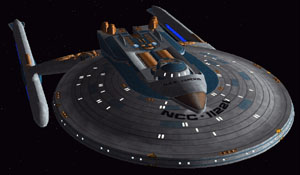
Cerberus – fore dorsal Note the small shuttlebay |
From this recessed bay can launch two (2) Class-E Type-4S shuttlepods (1 pilot, 2 passengers) for short-range personnel transport where the use of transporters is contra-indicated, and four (4) Class-C Work Bee multi-purpose maintenance craft for exterior hull inspection and repair. Several attachment sleds for the Work Bees are also stored in the shuttle bay, primarily waldo arms for repair work.
With casualties from the I.S.C. War already high and projected only to increase, this new class of ship was expected to be run by minimal staff. This idea was further reinforced by the expectations of a class of several hundred vessels. With so many needed and with qualified crew numbers dropping, a reduced crew was inevitable. However, just how reduced remained to be seen.
Starfleet's Sapient Resources Department did a being-power study on precisely what duties were expected to be performed and when, what equipment would be aboard requiring what specialists to operate it, and what the expected mission profile was intended to be. What they came up with was surprising. With the majority of time aboard these ships expected to be simply monitoring and interpreting data from sensitive systems and maintenance of those systems and more typical shipboard equipment, it was found that a standard full shift could be broken down into shorter shifts of skeleton crew. Using a more military watch rotation of 4-on, 4-off, 4-on, 4-off, 8-asleep, crew focus could be kept well honed and not lose their edge during their deep-space trawling for contacts. When something occurred, more specialists could be summoned in the affected department(s), a full watch could be instated, or battle-stations called. In this manner the crew complement was reduced by almost half, from an expected one hundred and fifteen (115) to a mere sixty (60).
With standard outfitting of the 100m diameter saucer granting crew quarters for one hundred and twenty (120), significantly expanded crew recreation facilities could now be installed in the hull volume saved by this reduction in crew. This further enhanced the time on-station these vessels could maintain. The choice now came down to installing those crew facilities or allowing individual staterooms. The former would allow for greater mental diversions and physical activities as respite from the stress and press of duty. The latter would allow for that most sacred of concepts (to some species): privacy. A place of your own to retreat to to get away from everything else was never an element to be underestimated in maintaining crew cohesion and individual focus.
In the end it was decided to trial both arrangements, with all ships built in a construction yard to the same specification, and different construction yards building the different internal arrangements. This would enable Starfleet's Sapient Resources a perfect field study opportunity. However for the prototype the full number of crew quarters were included, so that if it were determined that Sapient Resources being-power study had drawn inaccurate conclusions the vessel could be fully crewed with no additional time required in the yards to render her usable.
Tactical considerations were provided for in several somewhat unusual decisions.
Phaser systems for the Apollo's hull could no longer be installed in the typical Excelsior locations as the downsizing to just over half the original saucer dimensions rendered that installation problematic. Installation of power conduits to both dorsal and ventral emitters would take up hull volume that could be better purposed for habitation areas and other equipment.
Further, it was shown in simulation that for the intended warp reactor recharging the phaser banks for that many emitters fired at once – with overlapping fields of fire enabing many of them to be used at once on a single target – caused such a power drain as to render the ship sluggish and vulnerable. Never a desirable happenstance in battle even on a damaged ship never mind one which had been designed that way, a new phaser suite arrangement was developed.
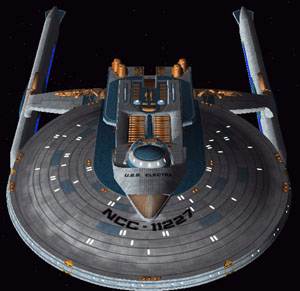
Electra – fore dorsal Note the triple phaser emitters around the saucer rim |
It was determined through extensive computer modelling and simulated trials that the best location for phasers on this ship with her expected high manoeuvrability would be at the saucer rim. Experience had shown that more often than not a single strike was all you got against a slippery raider, Corsair, or Bird of Prey; as these extremely mobile and nimble craft were the expected main opposition, coupled with the decision to rule out ventral emitters, it was determined that triple emitters would best suit individual weapons banks for sufficient weight of fire to impact a target.
The Apollo would be handsomely outfitted with these, boasting seven (7) banks positioned all around the saucer rim. Much of the combat the Apollo class was expected to be engaged in would be twisting dogfights more reminiscent of fighter craft battles; to this end the port and starboard weapons arcs featured two banks of triple emitters, whereas the fore and aft arcs were to be backed up by the planned photon tubes.
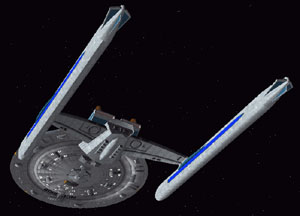
Leander – aft ventral starboard quarter Note the modified Miranda-style photon pod and LN-76 nacelles |
However, with no volume or proper firing arcs available from within the saucer itself, heavy weaponry was provided for by the incorporation of a full-sized photon torpedo pod from the evergreen, extremely successful Miranda-class light cruiser. Rotated 180° from its normal orientation this allowed the engagement of targets to the fore and aft, and in case of being chased herself the rear tubes would hopefully dissuade such pursuit. Coupled with the anticipated high manoeuvrability of the Apollo class it was expected that the time between fore and aft volleys at a single target would be measured in seconds or less, allowing the full weight of Apollo's wrath to be felt should an opponent wish to risk it.
Due to her role and anticipated mission profile, the full Miranda-class complement of photon torpedoes were also included to extend her time between returning to base for re-supply.
The development of both the Phantom 9-class passive super scout and the Dupleix-class perimeter action ship in the early 2290s gave rise to a nacelle arrangement unique in Starfleet history: that of vertically-stacked nacelles. In each case the reason for it was different, but due to the Apollo class seeking both aspects this arrangement was seriously considered.
The Phantom class' stealth was achieved through tricky warp-field manipulation of both nacelles operating simultaneously. The calibrations were famously difficult and notorious for falling out of alignment after each mission, but there was no denying their effectiveness. On the other side, the Dupleix alternated use of her nacelles, using each one in the standard escort-type fashion at emergency speed until just before shutdown before transitioning to the second nacelle to extend her sprint for an immediate doubling of the pursuit duration. This also allowed the first nacelle its cool-down time to possibly be reused again, in an alternating pattern for effectively an almost unlimited emergency warp pursuit duration.
The notion of utilising this arrangement was soon discarded after extensive modelling. Quite apart from the inability of combining both these elements within two nacelles, the tricky calibrations of the stealth aspect could not be further reduced and negated its use in the context of a combat unit. Further, the mass and positioning of two full-sized LN-6x-series nacelles reduced projected manoeuvrability considerably.
The final death knell for this nacelle arrangement was sounded by the lack of fuel efficiency and lower Time Between Component Failure (T.B.C.F.). For a class that had to be long-legged and hardy, this simply was not an option. In the end, a cruiser-style twin-nacelle "tuning fork" arrangement was chosen as the antithesis of the above problems, as well as delivery of guaranteed high sustainable cruise and emergency speeds.
With the innovation of using a Miranda-class photon pod attached directly below Main Engineering in the saucer section, this further allowed the use of the Miranda-class roll bar as the support pylons for the warp nacelles. Already containing the E.P.S. transfer conduits for power supply to the pod from the Miranda's warp reactor, these pylons were specially reinforced and bolstered by the Structural Integrity Field (S.I.F.) to withstand the stresses of holding onto the ship's nacelles at very high warp speeds.
With this choice made, the nacelles themselves had yet to be selected or even their design finalised. After examining all current technology it was decided that a cut-down version of the Excelsior-class' Advanced Circumferential Engine (A.C.E.) would be used. Utilising Excelsior's advanced technology engines and skewing their operational use in the same direction as the Belknap-class' renowned LN-68s for greater acceleration at the cost of faster dilithium decay rates, the LN-76 nacelle created specifically for the Apollo class had its design frozen and construction began for trials on a engineering test-bed ship.
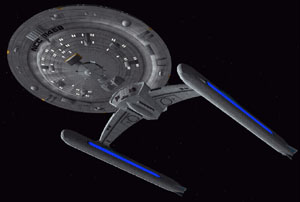
Hermione – fore ventral starboard quarter Note the various passive sensor antennae on the saucer underside |
All these aspects save crew facilities were well within the typical aspects of a Perimeter Action ship, albeit a larger, luxuriously appointed one. Where the Apollo really distinguishes herself is in the festooning of her ventral saucer surface with multiple long-range passive sensor arrays. While only around one-quarter the effectiveness of a dedicated super scout's main passive array, these additions give the Apollo a massive boost to her sensor range and an unrivalled edge in the acquisition of targets while remaining undetected herself.
Three main types of sensors, each monitoring overlapping sensor frequency bands, allow the Apollo to perform Target Motion Analysis (T.M.A.) tracking of contacts, much like the nuclear-powered attack submarines of many pre-warp civilisations.
The final edge granted to the Apollo is that of "self-quieting" technologies. While the LN-76 nacelles incorporate low-observability operating characteristics, multiple external systems festooning the nacelle pylons and the outer hull of the Engineering decks are instrumental in subduing the the energetic and "noisy" warp field. These systems can be engaged to varying levels of effectiveness. They can:
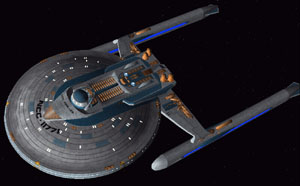
Achilles – fore starboard dorsal quarter Note the various bronze exterior engineering enhancement technologies |
However, due to the nature of these self-quieting technologies, operating in "stealth mode" affects the stability and coherence of the warp field and thus affects the vessel's top speed and fuel efficiency. Once the target is aware of the presence of a Starfleet vessel, or if a stealth approach is not needed or no longer necessary, the self-quieting systems can be disengaged with almost immediate effect for full emergency speed at 100% efficiency. To that end, further external systems around the impulse engines housing and on the warp nacelle casings temporarily boost efficiency to 115% standard capability for sprint durations.

Apollo – deck directory Click to enlarge. |
The design finalised accordingly, the first Flight 0 prototype NX-9173 8 began construction in 2297 at A.S.D.B.'s major integration facility at Starbase 134 over Beta Rigel VI, famous as a source of the now ubiquitous Miranda-class light cruiser. Two years later the U.S.S. Apollo NX-9173 was commissioned into extensive trials and testing due to her many unique features and all-new design.
A full year of evaluations in expected mission profiles followed, with much of it performed in some of Starfleet's most remote and isolated test ranges and deep space proving grounds. The empty space was perfectly suited to the Apollo's mission role as well as being away from the prying eyes of those she had been designed and built to hunt down. The Apollo did well, meeting and in many aspects surpassing her requirements. The latter part of that year's tests involved actual live deployments in regions affected by the blight of unchecked pirate activity, and in the course of these trials she succeeded by use of her passive sensor arrays in enabling the capture of several small smuggler ships slipping through the Federation's sensor nets, and directly apprehended two pirate vessels herself in separate convoy raids.
On the strength of this almost tour-de-force performance Starfleet immediately sought authorisation and appropriations for a full-production class build for one hundred (100) vessels. Such was the level of confidence this class inspired in immediately bringing the pirate problem to heel that class production authorisation was granted with little opposition, though the appropriations number was reduced to an initial batch of thirty (30) vessels with options for a further seventy (70) in two or more batches as deemed necessary.
Construction began in 2300 in small shipyards in and around the most badly affected regions and by 2302 dozens of fully service-ready Apollo-class deep space prowlers were in space and making their presence felt, if not yet known.
Prowler operational doctrine is primarily like that of the many pre-warp planets' nuclear powered attack submarines 8. That is to say:
Operating within these guidelines wherever possible, the Apollo-class Prowler earns its new classification with restless but stealthy motion, always on the hunt, their multi-faceted sensors ever listening out for faint warp signatures and snippets of communications in regions which shouldn't have them that could indicate ongoing or planned smuggler or pirate activities.
Just like their SSN predecessors the Apollo class stalks alone in her territory, sometimes tracking suspects for hours, days, or weeks before pouncing. Flitting silently from one locale to another utilizing their unprecedented stealth capabilities, they are able to triangulate, localise, close, and shadow targets while remaining undetected. Should circumstance work against her and her presence is prematurely revealed, her more-than-impressive speed and firepower almost ensure that her stake-outs result in a bust rather than a wash-out.
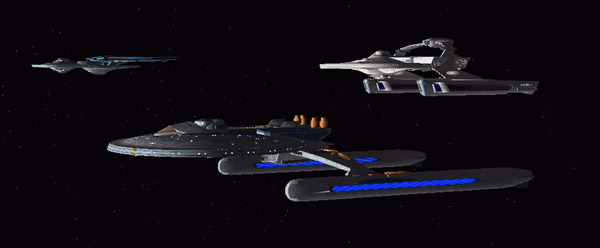
Electra, Trial, & Sheppey – Apollo, Miranda & Okinawa |
While excelling lone wolf operations, the Apollo class can also discretely signal for back-up should a situation develop into something more than she alone can handle. Usually in the form of a Tactical Fleet (TacFleet) Quick Response Force (Q.R.F.) destroyer or perimeter action ship, if the situation is truly desperate an Ascension-class light dreadnought can also be summoned to bail her out if she gets in over her head.
Even when deciding to sit out active operations such as interceptions and arrests, her passive intelligence reports can alert a whole sector and prepare merchant convoys, lone freighters, and civilian outposts and colonies for heightened pirate activity, and prepare Starfleet patrols, system defence squadrons, and planetary defence forces for anticipated anti-pirate operations.
In this way the Apollo class is both Starfleet's tripwire and trap 8 in the vast empty reaches of the interstellar desert. In the decade since their introduction in large numbers they have proven their worth time and again as ten times and more their weight in gold-pressed latinum, with property saved, lives and commerce protected, and in the peace of mind of many a colonist, freighter captain, starliner passenger, and pleasure craft operator.
They may not be seen and you never know where they may be, but you can be assured that one of them is out there somewhere, listening for trouble.

This article uses many entities from many sources, all included in my corner of the Star Trek universe because I like them enough to include them in it. However, I think it is past time these entities were credited to the people who created them in whatever form they take.
If you come down here from a note link from th article above, please click on the underlined note titles below to take you back to the section you came from.
1. Apollo-class Prowler images
Scottish Andy modification (minor component & overall mesh re-scaling; saucer rim, name & registry textures) of the Centaur-class light cruiser, mesh and textures © 2004 by Capt. LC Amaral.
(Basically, I rescaled LC Amaral's excellent model from a 383m Excelsior scale to a 210m Miranda-scale.)
2. I.S.C. War of Pacification
© Armarillo Design Bureau (A.D.B.), Star Fleet Battles, Module C2 – New Worlds II § R13.0 – The Interstellar Concordium, with timeframe & events modified for my own universe.
3. Okinawa-class images
Scottish Andy modification (major mesh component rescaling and moderate texture modification) of a model by Moonraker with textures by Rick Knox a.k.a pneumonic81 a.k.a p81, Ganymad, & DuctTapeWonder from original Okinawa-class design by Taldren/Interplay in their P.C. games Starfleet Command (I, II, & OP) & Klingon Academy.
Since rebuilt and rescaled from Rick Knox' (a.k.a pneumonic81) 'Yorktown (refit)' fca model for SFC and new name and registry textures modifying those created by GotAFarmYet?/Khaliban for this model.
4. Akula-class images
Scottish Andy modification (major mesh component rescaling and moderate texture modification) of a mesh and its textures by WickedZombie45 of Demon Renegade Studios to more accurately depict the less-than-full-size dimensions of the original Akula-class design by Taldren/Interplay in their P.C. games Starfleet Command (I, II, & OP) & Klingon Academy.
5. Captain Adam Bucker
Digital VFX supevisor and model builder who built the model used as U.S.S. Centaur in DS9 Season 6 Episode 01 'A Time to Stand…'.
6. Akyazi-class perimeter action ship
© 1988, 1991 Guenther & Sofia, Ships of the Star Fleet – Volume Two/Number One (2290-91) AKYAZI-Class Perimeter Action Ships.
7. Dupleix-class perimeter action ship
© 1992 David Schmidt, Star Fleet Prototype – Issue 25: (2291-92), § Escorts pp40-43.
8. "5-S Criteria" & "Starfleet's tripwire and trap"
Courtesy of my good friend Adrian Jones at U.S.S. Sheffield NCC-1976 / Star Trek: The Interim Years.
9. Phantom-class super sout
© 1991 David Schmidt, Star Fleet Prototype – Issue 25: (2291-92), § Escorts pp48-51.